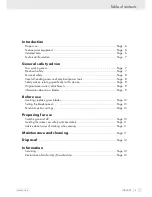
9
GB/IE/CY
move freely. Check for any parts that are
broken or damaged enough to detrimen-
tally affect the functioning of the device.
Have damaged parts repaired before
you use the device.
Many accidents have their
origins in poorly maintained electrical power tools.
f)
Keep cutting tools clean and sharp.
Care-
fully maintained cutting tools with sharp cutting edg-
es are less likely to jam and are easier to control.
g)
Use the electrical power tool, accesso-
ries, inserted tools etc. in accordance
with these instructions and advice, and
the stipulations drawn up for this
particular type of device. In doing this,
take into account the working condi-
tions and the task in hand.
The use of
electrical power tools for purposes other than
those intended can lead to dangerous situations.
Safety advice relating
specifically to this device
To avoid the danger of injury, fire and
damage to your health:
J
If you use the device outdoors, always connect
it through a residual current device (RCD) with
a maximum trip current of 30 mA.
J
Securely support the workpiece. Use clamps or
a vice to grip the workpiece firmly. This is much
safer than holding it in your hand.
J
Never support yourself by placing your hands
near or in front of the device or the workpiece
surface. A slip can result in injury.
J
If a dangerous situation arises, pull the mains
plug immediately out of the mains socket.
J
Always work with the mains lead leading away
from the rear of the device.
J
DANGEr oF FIrE FroM FLYING SPArKS!
Sawing metal creates flying sparks.
For this reason, always make sure that nobody
is placed in any danger and that there are no
inflammable materials near the working area.
WArNING!
NoxIoUS FUMES!
Working
with harmful / noxious dusts represents a risk to
the health of the person operating the device
and to anyone near the work area.
Wear protective glasses and a dust
mask!
J
Do not saw materials containing asbestos. As-
bestos is a known carcinogen.
J
When sawing building materials, observe the
statutory requirements and the manufacturer’s
recommendations.
J
Do not work on moist materials or damp surfaces.
J
Switch the device on before you bring it into
contact with the workpiece.
m
CAUTIoN!
Do not allow the blade to come
into contact with a solid object or the floor
when the device is operating – danger of kick-
back!
J
The shoe
7
must always lie against the work-
piece when the device is sawing.
J
Do not put the device down before it has been
switched off and has reached a standstill.
J
Use only sharp, defect-free blades. Replace
cracked, bent or blunt saw blades immediately.
J
Always keep the device clean, dry and free of
oil or grease.
Q
original accessories /
attachments
J
Use only the accessories detailed in the operat-
ing instructions. The use of inserted tools or ac-
cessories other than those recommended in the
operating instructions could lead to you suffer-
ing an injury.
Q
Information about saw blades
You can use any saw blade as long as it has the
correct shank fitting -
1
/
2
“ universal shaft. There are
different saw blades available in various lengths
designed to ensure optimum performance of every
sawing task with your sabre saw.
Note:
TPI = teeth per inch / (i.e. per 2.54 cm)
Blade (wood)
12
:
Dimensions: 150 x 1.25 mm, 6 TPI
Most suitable for: Sawing construction timber, chip-
board, processed wood boards, plywood. Also
suitable for plunge cuts.
General safety advice




























